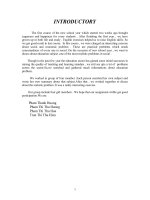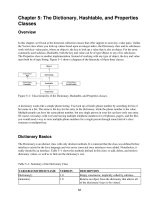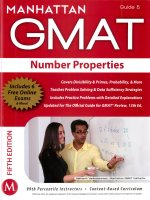NUMBER PROPERTIES THE OPERATION CALLED ADDITION
Bạn đang xem bản rút gọn của tài liệu. Xem và tải ngay bản đầy đủ của tài liệu tại đây (359.14 KB, 80 trang )
MATH TIPS
for
PARENTS
NUMBER PROPERTIES
THE OPERATION CALLED ADDITION
Associative Property of Addition:
•
Changing the grouping of the terms (addends) will not
change the sum (answer in addition).
In Arithmetic: (5 + 3) + 2 = (3 + 2)
In Algebra:
(a + b) + c = a + (b + c)
Commutative Property of Addition
•
Changing the order of the numbers (addends) will not
change the sum (answer in addition).
In Arithmetic: 8 + 4 = 4 + 8
In Algebra:
a+b=b+a
Identity Property of Addition
•
Zero added to any given number (given addend), the sum
will equal the given number (given addend).
In Arithmetic: 6 + 0 = 6
In Algebra:
a+0=a
Inverse Operation of Addition
• Subtraction undoes the operation called addition.
In Arithmetic: If 7 + 4 = 11, then
11 - 7 = 4 and 11 - 4 = 7
In Algebra:
a + b = c, then
c - a = b and c - b = a
THE OPERATION CALLED SUBTRACTION
Inverse Operation of Subtraction
•
Addition undoes the operation called subtraction.
In Arithmetic: If 16 - 9 = 7, then
9 + 7 = 16 and 7 + 9 = 16
In Algebra:
c - b = a, then
b + a = c and a + b = c
THE OPERATION CALLED DIVISION
Inverse Operation of Division
•
Multiplication undoes the operation called division.
In Arithmetic: If 48 / 8 = 6, then
8 x 6 = 48 and 6 x 8 = 48
In Algebra:
c / b = a, then
b x a = c and a x b = c
THE OPERATION CALLED MULTIPLICATION
Associative Property of Multiplication
•
Changing the grouping of the factors will not change the
product (answer in multiplication).
In Arithmetic: (5 x 4) x 2 = 5 x (4 x 2)
In Algebra:
(a x b) x c = a x (b x c)
or (ab) c = a (bc)
Commutative Property of Multiplication
•
Changing the order of the factors (multiplicand and
multiplier) will not change the product (answer in
multiplication).
In Arithmetic: 6 x 9 = 9 x 6
In Algebra:
a x b = b x a or ab = ba
Identity Property of Multiplication
•
The product (answer in multiplication) and 1 is the original
number.
In Arithmetic: 7 x 1 = 7
In Algebra:
a x 1 = a or a • 1 = a
Multiplication Property of Zero
•
The product (answer in multiplication) of any number and
zero is zero.
In Arithmetic: 9 x 0 = 0
In Algebra:
a x 0 = 0 or a • 0 = 0
Multiplication is repeated addition.
8x4=8+8+8+8
Distributive Property of Multiplication
over Addition or Subtraction
•
Multiplication by the same factor may be distributed over
two or more addends. This property allows you to multiply
each term inside a set of parentheses by a term inside the
parentheses. *In many cases this is an excellent vehicle for mental math.
In Arithmetic: OVER ADDITION
5(90 + 10) = (5 x 90) + (5 x 10)
OVER SUBTRACTION
5(90 - 10) = (5 x 90) - (5 x 10)
In Algebra:
OVER ADDITION
a(b + c) = (a x b) + (a x c) or
a(b + c) = ab + ac
OVER SUBTRACTION
a(b - c) = (a x b) - (a x c)
GLOSSARY of
MATHEMATICAL TERMS
Add/Addend/Addition/Array
ADD
To put one thing, set or group with another thing, set or group.
ADDEND
Numbers to be added.
Example:
12 + 23 = 25
a + b + c = abc
ADDITION
The operation of putting together two or more numbers, things,
groups or sets.
Example:
8 + 2 + 4 = 14 is an addition problem
ARRAY
An orderly arrangement of persons or things, rows and columns.
The number of elements in an array can be found by multiplying
the number of rows by the number of columns.
Example:
* * * * * *
* * * * * *
* * * * * *
3 x 6 = 18
Associative Property of Addition-Multiplication/Attribute
ASSOCIATIVE PROPERTY OF ADDITION
The way in which three numbers to be added are grouped two at a
time does not affect the sum.
Example:
3 + (5 + 6) = (3 + 5) + 6
3 + 11 = 8 + 6
14 = 14
ASSOCIATIVE PROPERTY OF MULTIPLICATION
The way in which three numbers to be multiplied are grouped two
at a time does not affect the product.
Example:
3 x (2 x 6) = (3 x 2) x 6
3 x 12 = 6 x 6
36 = 36
ATTRIBUTE
A quality that is thought of as belonging to a person of thing.
Characteristics; such as, size, shape, color and/or thickness.
Average/Axis
AVERAGE
A number found by dividing the sum (total) of two or the sum
(total) of two or more quantities by the number of quantities.
The average of 86, 54, 9 and 93 is 68.
STEP 1
STEP 2
86
54
39
+ 93
272
68
4) 272
- 24
32
- 32
0
How many addends?
Quantity is 4
sum or total
is the average
AXIS (axes)
Horizontal and vertical number lines in a number plane.
Bar Graph/Braces
Colors the Class Likes
BAR GRAPH
A picture in which number information
is shown by means of bars of
different lengths.
25
20
15
10
0
BRACES
Braces are symbols { }. They are used to list names of numbers
(elements) of a set.
Example:
{ Pauline, April, Joni, Jackie} is a set
of secretaries.
{Sunday, Monday, Tuesday, Wednesday,
Thursday, Friday, Saturday} is a set of
the days of the week.
{1, 2, 3, 4, 5, 6, 7, 8, 9} is a set of counting
numbers from 1 to 9.
Capacity/Cardinal Number/Centigrade/Cent/Centimeter
CAPACITY
The amount that can be held in a space.
CARDINAL NUMBER
A number that tells how many there are.
Example:
There are five squares
CENTIGRADE
Divided into one hundred degrees (100%). On the centigrade
temperature scale, freezing point is at zero degrees (0%). The
boiling point water is at one hundred degrees (100º)
* Celsius scale is the official name of the temperature
CENT
A coin of the United States and Canada. One hundred cents
make a dollar.
CENTIMETER
A unit of length in the metric system. A centimeter is equal to one
hundredths of a meter or .39 of an inch.
Century/Closed Figure/Closure
CENTURY
A period of one hundred years.
CLOSED FIGURE
A geometric figure that entirely encloses part of the plane.
CLOSURE
A property of a set of numbers such that the operation with two or
more numbers of that set results in a number of the set.
Example: In addition and multiplication with counting
numbers, the results is a counting numbers.
2 + 4 = 6; 2 x 4 = 8
Thus, the counting numbers are closed under
these two operations.
In subtraction, if 4 is subtracted from 2, the result
(-2) is not a counting number. Also in dividing a
2 by 4, the results (1/2) is not a counting
number. Thus, the counting numbers are not
closed with respect to subtraction and division.
Combine/Common/Common Factor/Common Multiple
COMBINE
To put (join) together.
COMMON
Belonging equally to all.
COMMON FACTOR
A common factor of two or more numbers is a number which is a
factor of each of the numbers.
Example: 8 = {1, 2, 4, 8}
32 = {1, 2, 4, 8, 16, 32}
1, 2, 4 and 8 are the common factors of 8 and 32
COMMON MULTIPLE
A common multiple of two or more numbers is a number which is
a multiple of each of the numbers.
Example: 12 = {12, 24, 36, 48, 72, 84, 96, 108, 120}
15 = {15, 30, 45, 60, 75, 90, 105, 120, 135, 150}
60 and 120 are the common multiples
Commutative Property of (Addition)(Multiplication)/
Compare/Composite Number
COMMUTATIVE PROPERTY OF ADDITION
The order of two numbers (addends) may be switched around and
the answer (total, sum) is the same.
Example:
7 + 4 = 11 and 4 + 7 = 11;
therefore, 7 + 4 = 4 + 7
COMMUTATIVE PROPERTY OF MULTIPLICATION
The order of two numbers (factors) may be switched around and
the answer (total product) is the same.
Example:
8 x 6 = 48 and 8 x 6 = 48;
therefore, 8 x 6 = 6 x 8
COMPARE
To study, discover and/or find out how persons or things are alike
or different.
COMPOSITE NUMBER
A number which has factors other than itself and one.
Since 16 = 1 x 16, 2 x 8 and 4 x 4, it is a composite number.









